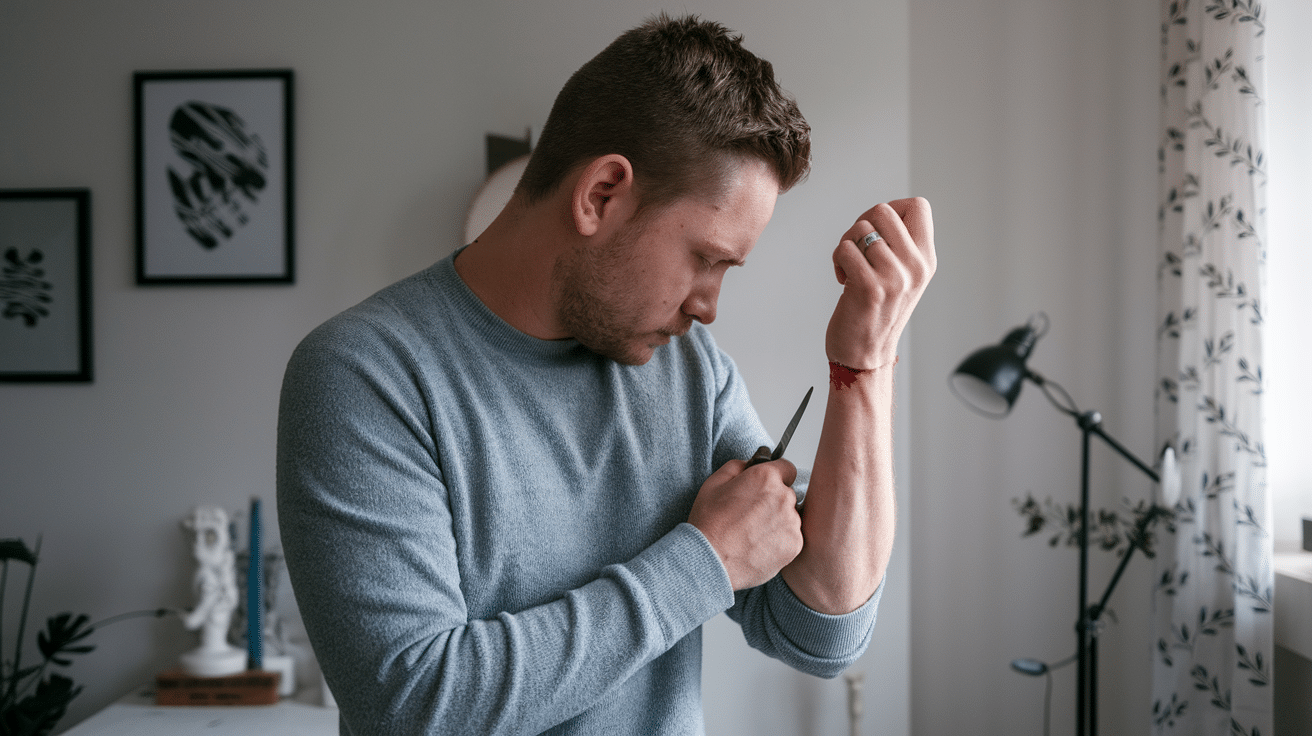Studies show that teens who hurt themselves on purpose (without wanting to die) respond differently to treatment.
Some get better, while others may get worse or return to self-harm. However, understanding what helps predict these different results can help doctors create better treatment plans for each person.
When thoughts of hurting yourself feel strong, having a clear plan helps you stay safe. This blog will help you build a safety plan when times get tough.
Let’s begin making your personal safety plan together.
What is Self-Harm and Its Types

Self-harm happens when someone purposely hurts themselves as a way to cope with painful feelings, memories, or situations.
It often serves as an outlet when emotions become too heavy to handle. And it can take different forms.
Some common types include:
- Cutting or scratching the skin with sharp objects
- Hitting or punching oneself
- Burning the skin
- Pulling out hair
- Taking too many pills
- Not letting wounds heal
- Eating disorders as a form of self-injury
Each person’s experience with self-harm is unique. The behaviors might change over time or happen in cycles.
So, understanding these patterns helps build better safety plans. With the right help and coping tools, recovery is possible.
How to Recognize the Warning Signs of Relapse
| Category | Signs/Symptoms |
|---|---|
| Emotional Changes | Feeling empty or numb inside |
| Quick shifts between different moods | |
| Getting upset over small things | |
| Feeling worthless or hopeless | |
| Strong guilt or shame | |
| Wanting to be alone all the time | |
| Changes in Daily Life | Sleep problems: too much or too little |
| Skipping meals or eating too much | |
| Dropping usual activities | |
| Focusing issues at work or school | |
| Not taking care of basic needs | |
| Physical Signs | Feeling very tense or restless |
| Headaches or body pains | |
| Racing heart or breathing fast | |
| Feeling tired all the time | |
| Stomach problems | |
| Thought Patterns | Thinking about past self-harm |
| Planning how to get tools for self-harm | |
| Believing others would be better off without you. | |
| Having trouble seeing good things ahead | |
| Thinking about death more often |
Know that seeing these signs doesn’t mean failure. They’re like an early warning system, a chance to use your safety plan and seek help.
How to Prevent a Self-Harm Relapse

Taking steps to prevent relapse helps build stronger protection against self-harm.
Here’s what helps:
1. Make Your Space Safe
Making your space safer helps reduce the risk of self-harm. Start by removing any objects that could be used for self-injury, storing them away from easy reach.
Keep a list of emergency numbers near your phone or post where you can find them quickly.
Create a special spot in your home that feels peaceful and calming – a corner of your bedroom or a cozy chair with soft blankets and pillows.
Add comfort items like stress balls, favorite books, or soothing pictures. For added safety, ask someone you trust to hold onto medications, giving you only the daily doses you need.
These small changes to your space build an environment that supports healing and makes it harder to act on harmful urges when they arise.
2. Build Daily Safety Habits
“Creating a steady daily routine forms the foundation of self-harm prevention.
Setting fixed times for meals helps maintain stable energy and mood throughout the day. Following a regular sleep pattern, with set times to go to bed and wake up, keeps the body and mind balanced.
Breaking down each day into small, manageable tasks makes life feel less overwhelming. Taking brief walks outdoors provides fresh air and natural mood boosts.
Keeping a notebook handy to write down thoughts and feelings creates a healthy outlet for emotions when they feel too strong.
Learning and using simple breathing exercises offers a quick way to calm down during stressful moments. These basic daily habits work together to build stability and strength for managing difficult times.
3. Stay Connected
Staying connected with others plays a key role in preventing self-harm. Sending a daily text to a friend keeps social bonds strong and ensures regular contact with people who care.
Taking part in support groups, either online or face-to-face, helps build connections with others who understand similar struggles.
Making and keeping therapy sessions creates a steady source of professional support and guidance. Sharing your safety plan with trusted family members or friends means they know how to help during tough times.
Having someone check on you daily adds an extra layer of support and shows you’re not facing challenges alone.
These connections create a strong support system that helps during good and hard times.
4. Try New Coping Methods
Different methods help manage self-harm urges in safer ways. Holding ice cubes creates a strong physical feeling without causing harm while drawing with red markers offers a safe visual outlet.
Punching pillows is a healthy way to release strong feelings of anger or frustration. Playing calm music shifts attention to pleasant sounds and helps soothe racing thoughts.
Counting items around the room helps the mind focus on the present moment instead of difficult feelings.
Using the five senses method – noticing things you can see, hear, touch, smell, and taste – grounds you in the current moment when thoughts become too intense.
These simple tools give quick, practical ways to handle urges without causing harm.
5. Get Extra Help When
Knowing when to seek extra help can prevent self-harm urges from getting worse. Sometimes, the usual ways of coping stop giving relief, which signals a need for new strategies.
When daily pressures build up and feel too heavy to handle alone, it’s time to reach out.
If warning signs start appearing more often or with greater strength, this points to a need for added support.
Changes in your support network, like moving away from friends or switching therapists, can leave gaps that need filling.
When negative thoughts become louder or more frequent, telling someone before they grow stronger is crucial.
These signs don’t mean failure – they show it’s time to strengthen your support and perhaps try new ways of staying safe.
What Recovery from Self-Harm Feels Like

The path to getting better from self-harm moves at its speed. Each person goes through changes that show healing is happening, even when it doesn’t feel like it.
In the first few weeks and months, the urge to self-harm might still feel strong. Many people notice their old habits, trying to return when stress hits.
As time passes, people often notice longer stretches between hard days. They get better at catching warning signs before things get bad.
Many find their bonds with friends, family, or therapists growing stronger. The shame about past self-harm starts to fade.
People find new ways to handle their emotions that don’t involve hurting themselves.
Some even start sharing their story to help others, turning their past struggles into something meaningful.
Each person’s healing looks different, and there’s no wrong way to get better if you’re moving toward health.
Physical scars might stay, but their meaning often changes. Many people start seeing them as marks of survival rather than shame.
What to Do if You Have Self-Harm Relapse

When self-harm happens again, the first step is to make sure you’re physically safe.
If there are serious injuries, medical help comes first. Clean the wounds, use bandages if needed, and watch for signs of infection.
This basic care matters for both your physical and mental health. It shows you’re taking steps to protect yourself, even after a hard moment.
Look at what happened before the relapse. Were there new stresses? Did usual coping skills stop working? Did support systems change?
Get back to basic self-care right away. Eat regular meals, try to sleep enough, and spend time with supportive people. These simple steps help rebuild stability.
Remember that each day is new. A relapse feels big, but it’s one moment in a longer story of healing.
Conclusion
Building a safety plan and understanding self-harm recovery takes time and patience.
And a safety plan isn’t just a document; it’s a promise to keep yourself safe during tough times.
Knowing the warning signs, having clear steps, and building a support network, you’re better prepared to handle hard moments.
Remember, recovery isn’t about perfect progress. Some days will be harder than others, and that’s okay.
What matters is your commitment to staying safe and healthy.
Frequently Asked Questions
How Do You Tell Someone You Relapsed from Self-Harm?
Say it honestly and calmly. “I relapsed, and I need support.” Pick someone you trust. You don’t have to explain everything—just let them know you need help.
How to Help Someone Who Harms Themselves?
Listen without judging. Say, “I’m here for you.” Don’t force advice—offer support. Please encourage them to talk to someone who can help, but don’t push too hard.
How Do I Be Kind to Myself After the Relapse?
Remind yourself that setbacks happen. Say, “I messed up, but I can try again.” Do something comforting—listen to music, rest, or talk to someone who understands.








